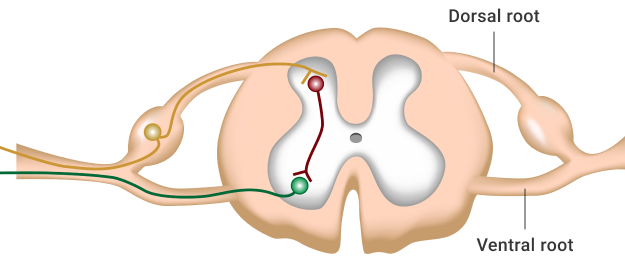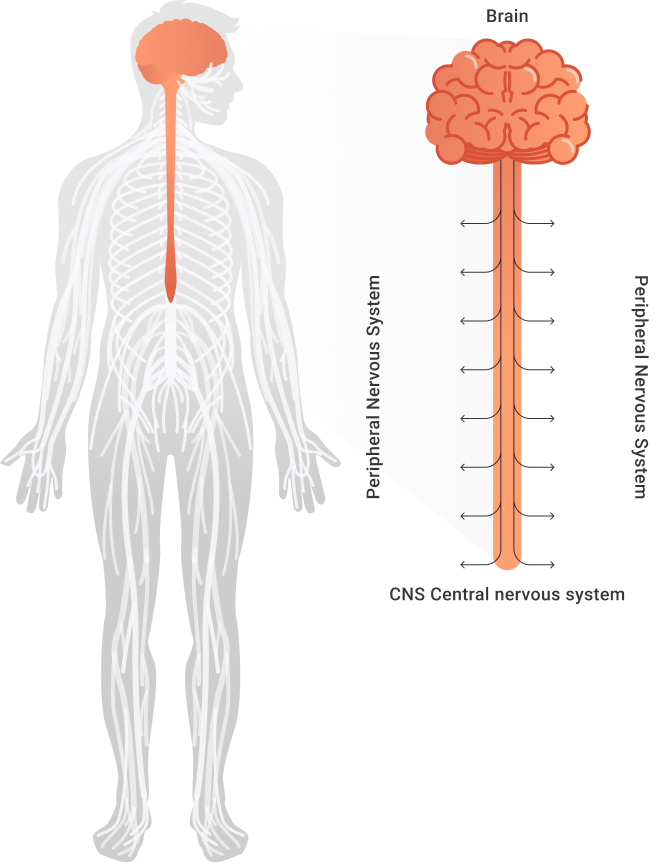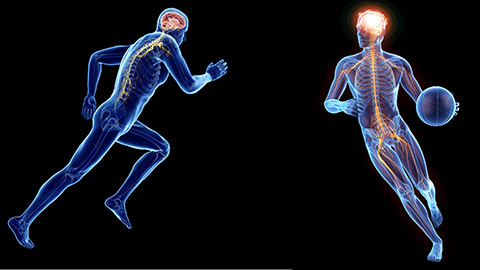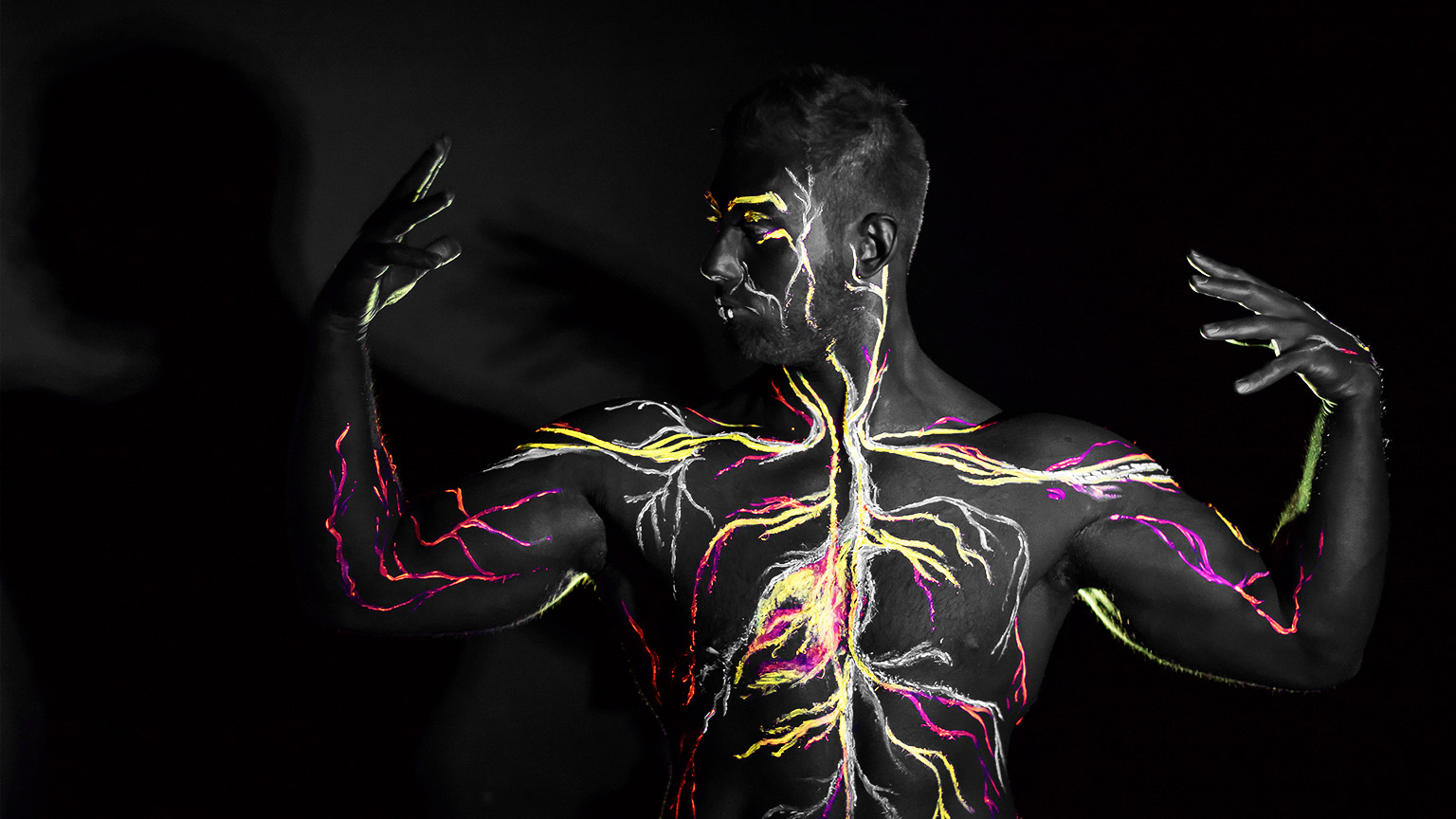Introduction
Welcome to the Nervous System! In this module we will explore the different divisions of the nervous system, understanding how they cooperate to keep our bodies functioning smoothly. Next, we will learn about the key structures of the nervous system, from the brain and spinal cord to the extensive network of nerves, and how these parts interact to perform essential functions.
We will then explore how our bodies respond to stimuli and the crucial roles the nervous system plays in supporting physical activity. You’ll also learn how the nervous system controls movement, initiates muscle actions, and ensures coordination during physical tasks.
Additionally, we will cover how the different parts of the nervous system communicate, and how specialised sensory receptors help to enhance performance and prevent injury. Finally, we'll discuss how regular exercise positively impacts the nervous system, leading to long-term improvements in coordination and neural efficiency.
You have already begun your study on this topic in face-to-face classes. The first part of this online session will focus on recapping your learning so far. We will then cover some new material to expand your knowledge of the topic. Towards the end of this week’s online learning, we will start to prepare for your first assessment task on the skeletal and nervous systems and introduce the next of our topics, the muscular system.
Let’s get started! Enjoy your second week on online learning.
The nervous system is arguably the most important system in the body. It facilitates, monitors and actions every other organ system to ensure the many vital functions of the body are carried out as they should be. It achieves this through the coordinated teamwork of a number of different divisions. The following activity is designed to check your understanding of the main divisions of the nervous system. Feel free to read over your notes on this topic before attempting these questions.
H5P here
The three main structures that make up the nervous system are:
- The Brain – the super-computer that receives, interprets and decides what to do.
- The Spinal Cord – the super-highway for communication that speeds message from the body to the brain and the brain to the body.
- The nerves (neurons) - the branches of nervous tissue that relay messages to and from the CNS.
The Central Nervous System
The central nervous system is made up of the brain and spinal cord. The CNS receives sensory information from the body. It analyses and processes this information in its various brain centres, decides on an appropriate response, and generates executive commands to be sent throughout the body to produce action.
The Brain
The brain is a phenomenon. It is comprised of different structures and regions that filter and processes billions of pieces of information a second, deciding in milliseconds what is important and what is not. It analyses the information it receives, decides on the best course of action, and then delivers and co-ordinates the instructions to get the job done as efficiently as possible. The brain has an almost unlimited capacity to learn, enhance and store information. We have covered information on the brain extensively in our face-to-face class.
The following task is designed to assess your awareness of the different parts of the brain and their basic functions. It may be worth revisiting your notes on the brain before attempting these questions.
H5P here
Interesting Brain Facts
H5P here
The Spinal Cord
The spinal cord is a super-highway for electrical signals. It serves as the connection between the brain and the nerves that carry messages to and from the body organs. The cord itself is a long, thin, tube-like structure that runs down your spine (protected by the vertebrae). It starts at the base of your brain and extends down to your lower back. Inside, it’s like a dense cable made up of nerve fibres. Each section of the spinal cord provides a connection to the brain for certain parts of your body.
- Cervical Region (Neck): Receives and sends signals to your arms, hands, and neck muscles.
- Thoracic Region (Upper/Mid-back): Receives and sends signals to the muscles and organs in your thoracic region along with the superior portion of your abdomen.
- Lumbar Region (Lower Back): Receives and sends signals to your abdomen, hips and legs.
- Sacral Region (Pelvis): Coordinates the control of your pelvic organs and parts of your legs.
Think of it as a relay station, where information is sent from your brain to different body parts and back again. Without it, you wouldn’t be able to feel or control your limbs or organs.
In all, there are 33 pairs of nerve roots that facilitate the entry and exit of electrical signals to and from the CNS via small gaps in the vertebral column.
Nerve Roots
The spinal cord has two main jobs: sending signals to the brain and sending commands back to your muscles and organs. It does this via two key roots that are set up like on and off ramps on a highway.
Spinal Cord Cross-section

-
The Dorsal Roots – (Sensory information)
Dorsal roots are the entryways for sensory information. Imagine you feel something uncomfortable in your shoe. That sensory information travels up through your foot, along nerves, and enters the dorsal roots of the spinal cord. From here, the information is quickly sent up to your brain, where you register discomfort and decide to wriggle your toes to move the object.
-
The Ventral Roots – (Motor information)
Ventral roots are the exit points for motor commands. Your brain sends a message back down the spinal cord telling your toe muscles to contract and move the object. These signals exit the spinal cord through the ventral roots of the spinal cord and relay the signals to the body that make the muscles move.
Essentially, the dorsal roots are for sensory "incoming" messages, and the ventral roots are for motor "outgoing" messages. It’s like a well-coordinated mailroom, sorting out incoming and outgoing signals in the body!
Every time you move your spinal cord is working hard behind the scenes. Quick reflexes, balance, and smooth coordination all rely on the efficient functioning of your spinal cord. In sports, where milliseconds can make the difference between success and failure, the spinal cord’s ability to rapidly transmit signals is key.
Spinal cord reflexes
Reflexes are designed to protect us. In order to do so, they must occur as fast as possible. Reflexes happen so isn’t even involved! Instead, pre-programmed reflex commands are stored in the spinal cord. The milliseconds we save by not involving the brain in the process could be the difference between a near miss and a serious injury (or death). Through this mechanism, the body can react to potentially dangerous stimuli, without you even being consciously aware of what the danger was.
An example of this is when you touch something hot. By the time your brain is aware of the hot touch (i.e., registers pain), you have already removed your hand from the hot surface. The brain will certainly register the effects of touching the hot surface but was not involved in the signalling to move the hand away from the hot surface (thus limiting damage to the skin). This is why reflexes are so fast and essential for preventing injuries.
The video below shows this reflex mechanism in action.
Central Nervous System, Reflex Arc
This video shows the mechanism of a reflex using the example of burning you hand on a hot surface.
- Post watch task: Once you have watched the video, attempt to answer the questions below
Source: YouTube
Complete this task relating to spinal cord reflexes by dropping the correct word into each space in the written passage.
H5P here
Spinal cord facts
- The Spinal Cord Isn’t as Long as You Think: It’s shorter than your spine! The spinal cord ends in the lower back (L5), but nerves continue to branch out, forming what looks like a horse's tail—this bundle of nerves is called the cauda equina (Latin for "horse’s tail").
- Spinal Cord Speed: Nerve impulses can travel at speeds of up to 268 miles per hour (that’s faster than a Formula 1 car!). This speed is critical when you need to react quickly during a sprint, dodge an opponent, or take an amazing catch!
The spinal cord may not get as much attention as the brain, but it's a vital player in every movement, reflex, and physical reaction you make. Whether you're learning a new sport, perfecting your technique, or responding to sudden challenges during competition, your spinal cord is there, making sure every move is smooth, quick, and coordinated. So, next time you sprint, jump, or stretch, remember that your spinal cord is your silent partner, working hard to make it all happen!
The Peripheral Nervous System

The PNS is a collection of neurons that reside within cords of nervous tissue called nerves. These neurons either keep the CNS informed about the internal environment of the body (e.g., oxygen levels, temperature etc.) or the external environment (e.g., sights, sounds, and sensations like touch). They conduct electrical signals generated by sensory neurons to the CNS and deliver electrical commands generated by the CNS to the organs of the body to cause action.
This task is designed to check your understanding of the structure and function of neurons in the body. Read over your notes on this topic, then attempt the questions below.
H5P here
Types of Neurons
The nervous system communication process can be explained using the following simple diagram:
The Nervous System Communication Process
There are three types of neurons that facilitate this process. They are known as sensory, inter and motor neurons. The following task is designed to check your understanding of these neurons, their functions, and the basics of nervous system function.

The motor division of the nervous system are responsible for causing actions. There are three main ways in which our body responds to stimuli. These are:
- Via voluntary actions – e.g., using skeletal muscles to carry out conscious actions.
- Via involuntary actions – e.g., using involuntary muscles, or organs to carry out unconscious actions.
- Via reflex actions – i.e., pre-programmed responses that result in quick action.
The following task is designed to check your understanding of how the motor divisions carry out response actions. Feel free to read over your course notes on this subject before attempting the questions below.
H5P here
The Role of the Sympathetic and Parasympathetic Nervous Systems in Sport and Exercise
You are now aware that the autonomic nervous system (ANS) is a key player in regulating involuntary physiological functions such as heart rate, blood pressure, digestion, and respiratory rate. It is divided into two main branches:
- Sympathetic Nervous System (SNS) - Often referred to as the "fight or flight" system, the SNS prepares the body for intense physical activity.
- Parasympathetic Nervous System (PNS) - Known as the "rest and digest" system, the PNS helps the body relax and recover after exertion.
These systems work in tandem to maintain homeostasis but have opposing effects. Understanding how they function, and influence exercise performance is crucial for optimising athletic performance.
The Sympathetic Nervous System (SNS) and Exercise
The SNS is activated during times of physical or mental stress, such as during exercise or competition. When the SNS is stimulated, several physiological changes occur:
- Increased Heart Rate and Blood Pressure: The SNS elevates heart rate and blood pressure to deliver more oxygen-rich blood to muscles.
- Bronchodilation: Airways expand, allowing for more oxygen intake, which is vital during aerobic exercise.
- Increased Blood Flow to Muscles: Blood vessels in the muscles dilate, improving nutrient and oxygen delivery.
- Release of Adrenaline (Epinephrine): This hormone boosts energy availability by increasing the breakdown of glycogen into glucose in the liver and muscles.
The SNS allows athletes to generate maximum force or power, react quickly and sustain short bursts of intense activity. For these reasons activating the SNS can provide real benefit to athletes involved in high intensity sports like sprinting, weightlifting or throwing events.
Athletes use a variety of means to stimulate the SNS. Some of the most common are shown in the picture sequence below:
H5P here
Managing Over-activation
While SNS activation is beneficial during competition, chronic overactivation (e.g., due to stress, nerves or overtraining) can lead to burnout or decreased performance. Athletes need to learn strategies for how to control their SNS, to remain calm and composed in important moments, but also to harness the SNS benefits when they need them. In sport, this often needs to be done multiple times during a game.
The Parasympathetic Nervous System (PNS) and Exercise
The PNS is most active during periods of rest and recovery, playing a critical role in helping the body repair and prepare for future activity. Some of the main functions it facilitates are:
- Reduced Heart Rate and Blood Pressure: The PNS slows down heart rate and lowers blood pressure, conserving energy.
- Enhanced Digestion and Nutrient Absorption: With reduced physical stress, the body can focus on digestion and nutrient absorption, aiding in recovery.
- Promotion of Restful Sleep: The PNS helps facilitate deep, restorative sleep, which is essential for muscle repair and growth.
Strategies to engage the PNS around sport and exercise can also be beneficial to athletes. Examples of this include:
- To settle pre-game nerves and excitement
- To help with recovery between trainings, events or games.
- To centre themselves during important moments (e.g., a winning free throw in basketball)
- When executing fine motor skills tasks that tension or nerves could affect (e.g. darts, pool, bowls etc).
- To switch off between explosive efforts (e.g. when waiting for your next jump during field events in athletics).
- To help sleep the night before a big event
Some common methods that athlete’s employ to activate their PNS are shown in the picture sequence below.
H5P here
Balancing the SNS and PNS for Optimal Performance
For athletes, the ability to regulate and balance the SNS and PNS is crucial. Too much SNS activation without sufficient PNS recovery can lead to burnout, while inadequate SNS activation may result in underperformance. Here are some considerations for different types of athletes:
Sports That Require Quick Transitions (image #1)
In sports like basketball or tennis, where players frequently shift between intense bursts of activity and brief moments of rest, the ability to quickly switch between SNS and PNS activation is vital. For example, a basketball player might use deep breathing during a timeout or centering with visualisation before taking an important free throw (PNS activation) to lower heart rate, but then need to reactivate the SNS for explosive movements when play resumes.
Endurance Sports (image #2)
Athletes in endurance sports need to manage SNS activation to avoid early fatigue while maximising PNS engagement during recovery phases to maintain long-term performance. For example, cyclists might use controlled breathing techniques during a race to moderate SNS activation, preventing premature exhaustion, and then focus on PNS recovery strategies post-race.
Combat Sports and Anxiety Management (image #3)
For athletes in sports like boxing or MMA, where anxiety can spike before competition, techniques that elevate PNS activity (e.g., mindfulness or focused breathing) can help maintain calm and focus, preventing excessive SNS activation that might lead to quick fatigue. SNS activation methods can then be used immediately prior to the bout to benefit from increased power, strength and quickness.
The task below will check your understanding of what autonomic nervous system division would be most beneficial for different sporting or exercise situations. Type either SNS or PNS under each of the images to indicate which nervous system division would be most helpful to activate in each situation.
H5P here

Aside from the obvious sensory receptors like feel, touch, pressure etc., there are an additional group of key sensory receptors that assist us during exercise. They help us to stabilise during movements and monitor our soft tissue to prevent injury.
The three that we will focus on are known as proprioceptors. They include:
- Joint Kinesthetic Receptors
- Muscle Spindles; and
- Golgi Tendon Organs
The following tasks are designed to check your recall of information regarding these three key receptors and how the assist and protect us during exercise and activity.
H5P here
The Mechanism of Stretching
To create an effective stretch, you need to activate the muscle spindle. Muscle spindles are essentially what cause the feeling of a stretch. The following task is designed to assess your understanding of the role of the muscle spindle in stretching. Complete the written passage by dropping the correct words into the spaces within the text.
H5P here
Increasing Flexibility
In order to increase your flexibility, you need to stretch in the proper way (regularly). The following task assesses your understanding of what proper stretching practice looks like, along with your knowledge of how to improve flexibility.
H5P here
When we exercise, our nervous system doesn’t just maintain current function, it actively adapts to make our movements more efficient, coordinated and powerful over time.
These adaptations are crucial for improving athletic performance and are a key focus in sports science. Understanding how the nervous system changes in response to exercise can help athletes optimise their training and reach their full potential.
This task is designed to check your understanding of the common neural adaptations that occur when we learn and practice new skills.
Drag and drop the neural adaptation term in to the empty space next to the descriptive sentence that best describes it.
H5P here
End of Topic
That’s it for the nervous system. You have now completed the first 3 topics of the module! Now that you have completed the content for both the skeletal and nervous system, you are ready to prepare for the first of your assessment events that assesses your knowledge of those topics.
Your first assessment event is scheduled for your next face-to-face lesson.
Assessment 1 (Part A) is an open book assessment conducted under test conditions. It will assess the first two topics that we have covered in your learning so far – The skeletal system & the nervous system.
The assessment is made up of nine questions relating to three different case study topics. The case study scenarios cover the following topics:
- bone structure and development
- common bone issues
- bone density related to exercise choice
- factors in joint stability
- the role of sensory proprioceptors in exercise; and
- neural adaptations related to exercise
You will be able to bring your learner resource and any other written notes into class.
Make sure, if you have missed any classes over the last 2 weeks, that you fill in any of the missing exercises in your learner resource. You can access any of the class presentations in your class teams under Module 2, week 1 and 2 to help you do this.
This final segment of online learning is to make sure you are fully prepared for the assessment next week. To complete the tasks below, you will want to have your learner resource handy, along with any other notes you have taken across the first 2 weeks of learning.
The following tasks will present case study scenarios that are similar too, but not the same as those you will be tasked with in the assessment. The assessments for this topic are not simply information recall. The questions are designed to assess your ability to apply what you have learned to the case study scenario presented.
What you need to do
The answers to these tasks will require you to find the relevant information that you need in your learner resource, then write it up as written paragraph answer (kind of like what you need to do in the assessment!).
Each case study scenario introduced will provide the topic knowledge that the answer will require. This way you can turn to the relevant section of your learner resource for easy access to the information you need.
Scenario 1
(Topic – bone structure and growth)
A parent of a 10-year-old boy you coach mentions she is thinking of taking him to the gym to build him up a bit for the rugby season. She read somewhere that children shouldn’t do resistance training as it can “stunt their growth or something”. She wants to know whether or not she should introduce her child to weight training.
H5P Essay
Scenario 2
(Topic – Bone growth (male vs female)
One of your teenage gym clients (18) is wondering if she is going to grow any taller. She was looking back at some old photos and noticed that in during an Intermediate school class photo she was significantly taller than her twin brother, but that now he is half a head taller than her. Can you explain this to her?
H5P Essay
Scenario 3
(Topic – Bone density and exercise)
A friend of yours is a keen gym goer, but only ever does cardio. They go to the gym 5 times a week. Their favourite cardio machines are the ski erg, cycle erg and the cross-trainer. They are fit as a fiddle! Last week your friend decided to test themselves and entered a competitive trail run. This week they have pulled up with a very sore shin that hurts when they walk, but especially when they go up or down stairs. When they looked up their symptoms on Google, it suggested they might have a stress fracture, but they don’t understand how that could be possible given all the exercise they do!
H5P Essay
Scenario 4 – (Joint stability)
You have just started working with an older female client at the gym. You perform a movement screen assessment on them and find that they are quite unstable when performing knee bend movements like the squat and partial lunge. They are brand new to the gym, have been inactive for some time, and has never done “fitness exercises”. They are quite disheartened after the first session and raise concerns, that it may not be worth continuing at the gym as they are so “weak and wobbly”.
H5P Essay
Scenario 5 – (GTO function)
Your friend Simon has just started joining you for some resistance training sessions at the gym. He is impressed with the weight you are able to press during your bench press set and wants to “give it a go”.
You try to warn him off the idea, but he is adamant he wants to try. He jumps under the bar, so you quickly position yourself to be able to spot him. He manages to get the bar off the rack and lower it, but as soon as he tries to push it up, he fails quickly. He said it felt like there was just “nothing there to push with”.
H5P Essay
You should now be ready!
Between the notes you have in your learner resource and the tasks you have just completed; you should be fully prepared for your first assessment event.
Good Luck!
Your next topic of study is the muscular system.
